Whoever enters my room, they never forget to compliment my plant assets.
Personally, I invest in Anthuriums for their aesthetic value and elegance, which make my space alive.
Among all indoor plants, Anthurium Macrolobium can provide your space with tropical vibes. And interestingly it doesn’t demand high maintenance and can easily be cared for by newies.
Generally, Anthurium macrolobium requires 6-7 hours of indirect bright light, temperature of 65 to 85°F, 50-70% humidity, and watering once or twice during growing season. Furthermore, It also requires phosphorus-rich fertilizer, repotting every 2-3 years, and well-draining soil to thrive.

Anthuriums are greatly known for purifying air by inhibiting harmful chemicals like ammonia and formaldehyde.
They would be a center of attraction at your home if raised with good care and love. So, with the same purpose, this article will be a perfect guide for you.
Table of Contents Show
Overview of Anthurium Macrolobium
Anthurium macrolobium is a rare and artificially hybridized species of Anthurium. It was first mentioned in a description of William Bull in 1883.
Later, European gardeners obtained the hybrid plant in during the late 1970s, and then commercially it was adopted.
Anthurium macrolobium is a cross between two different varieties of Anthurium, namely Anthurium leuconeurum and Anthurium pedatoradiatum.
The plant is adorned for its remarkable beauty that simply pleases the spectator’s eyes.
The usual flower and heart-shaped leaves with a pointed end brighten your living space.
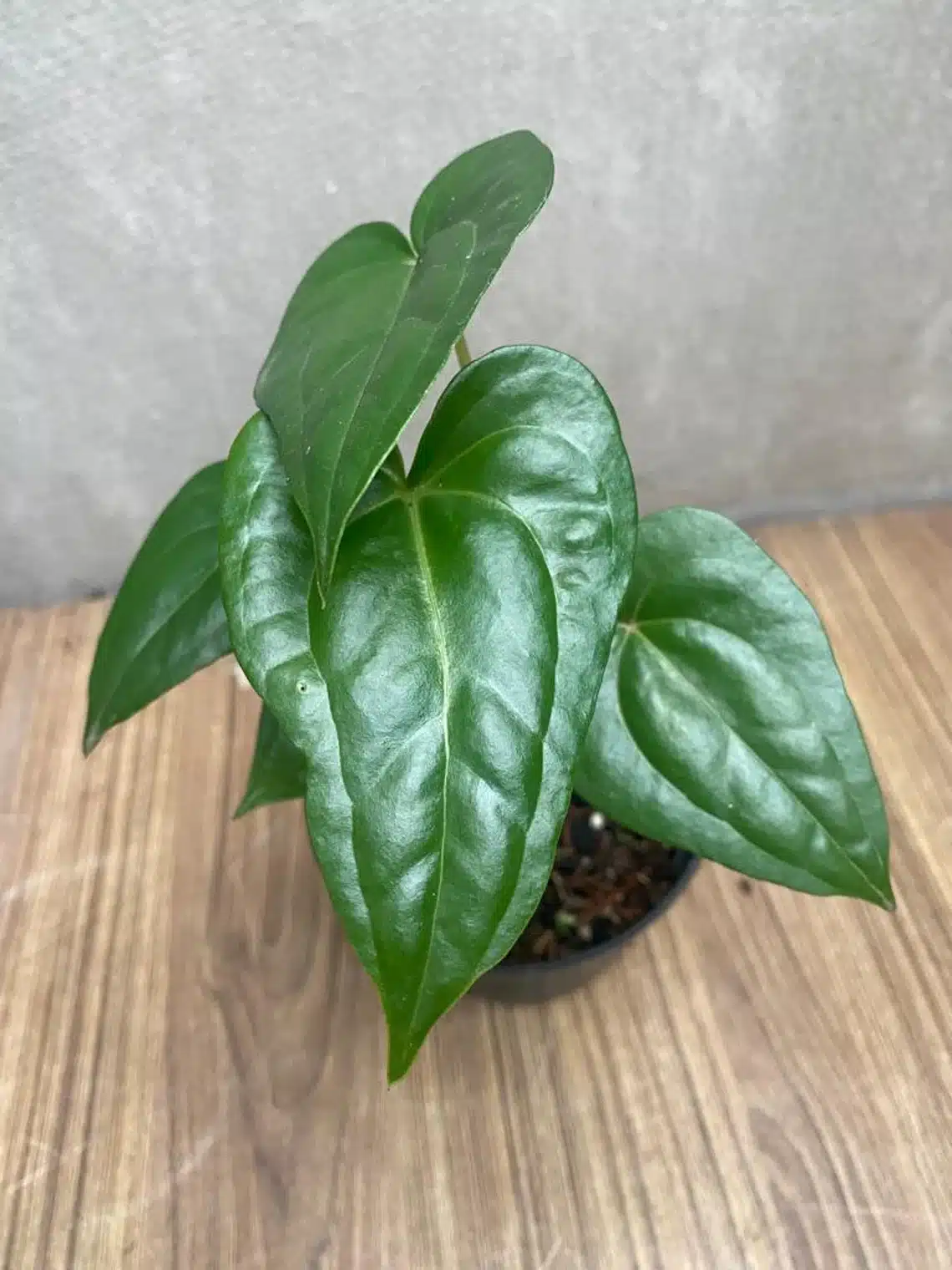
Here is a table containing comprehensive information about Anthurium macrolobium.
| Indicator | Identity |
|---|---|
| Botanical Name | Anthurium macrolobium |
| Others Name | Laceleaf plants, tail flowers and flamingos |
| Origin | Ecuador and other tropical and sub-tropical regions |
| Family | Araceae |
| Genus | Anthurium |
| Growth Zone | USDA Zone 10 or higher |
| Growth Rate | Medium, 4X3 feet |
| Flower | Large red spathe with a pointed yellow and white spadix in the middle |
| Blooming season | Spring and summer; lasts for about 3 months |
| Foliage | Vibrant, velvety, heart-shaped circumscribed with wavy or curved edges that end in a pointed tip |
| Toxicity | Toxic to both humans and animals |
Anthurium Macrolobium- Complete Grow & Care Guide
Anthurium macrolobium grows in subtropical or tropical moist montane forests and subtropical or tropical moist lowland forests naturally.
Although Anthurium macrolobium is a hybridized variety of tropical plants, it is not difficult to care for. If you can maintain a slight tropical environment, the plant thrives well.
Here are the primary care requirements that you have to follow for your Anthurium macrolobium.
| Parameters | Favorable Conditions |
|---|---|
| Sunlight | 6-7 hours of dappled sunlight |
| Temperature | 65 to 85 degree farenheit |
| Watering | 5-7 days in summer and 7-14 days in winter |
| Humidity | Above 70% of the relative humidity |
| Soil Type | Light, porous, chunky, nutrient and moisture retaining soil |
| Fertilization | Diluted liquid or organic fertilizer once in 1-2 months |
| Pruning | Rare pruning, once in 1-2 years |
| Pot | 5-8 inches, Terracotta or Clay pots |
| Repotting | Once in 2-3 years |
| Propagation | Via root-ball division, Stem cuttings, and seed germination |
| Common Pests | Mealy bugs, nematode, spider mites, and thrips |
| Common Disease | Bacterial blight, Root rot, and Black nose disease |
1. Bright Indirect Sunlight and Proper Location
The plant can thrive in a range of moderate to bright indirect light. Unlike other Anthurium varieties, Anthurium macrolobium is not extremely fussy about the light requirements.
Generally, Anthurium macrolobium needs 6-7 hours of indirect bright sunlight a day and relishes well under 75-80% shade.
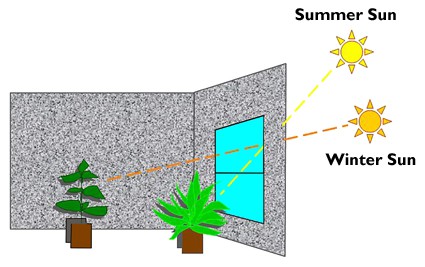
Do not deprive them of light, as this promotes drooping and wilting of the leaves as well as a reduction in photosynthesis rate.
Furthermore, under low light, it generates smaller leaves, causing the plant’s growth to be hindered.
Let’s look at the indications and symptoms of too much and too little sunlight in Anthuriums.
Here is a table of symptoms caused by improper sunlight.
| Symptoms of Insufficient Light | Symptoms of Excess Light |
|---|---|
| Decrease in chlorophyll pigments leading to a loss of vibrant green color, harming Photosynthesis. | Leaves get scorched and turn dry and crispy. |
| Leaves appear bleached, yellow, disclosed, and smaller in size. | Leaf margins turn yellow and brown. |
| When there is low energy production, it causes stunted, leggy, and dull growth. | It causes a high transpiration rate and leaves start to curl to reduce the surface area for moisture loss. |

Tips to Provide Adequate Sunlight to Anthurium Macrolobium
- While growing Anthurium macrolobium indoors, provide them with 60-80% of the total light intensity and 30-40% intensity outdoor.
- Always grow your Anthurium in shades and strictly avoid the sunny location.
- Locate the plant under tree shades or a patio reflecting only for a few hours of morning light.
- Similarly, place them near an eastern-facing window while growing them indoors.
- Place the plants in southern or western facing windows. But, work on protecting them from prolonged afternoon shades.
- Cover your window with a light curtain that blocks only the harsh rays.
- Place your Anthurium within 1-3 feet from the window to provide optimum light.
- Avoid frequent moving of the plant as the frequent shifting of the plant might cause transplant shock and stress.
Pro Tip: Rotate the plant once in 10 days to avoid unilateral growth.
Can Anthurium Macrolobium Thrive in Artificial Light?
If your space doesn’t support sufficient light for Anthurium macrolobium, you still grow them under partial natural and partial artificial light.

Here are tips to grow your Anthurium macrolobium under grow lights.
- Keep the plants within about 20-30 cm from the light source.
- Provide the plants with 7-8 hours of full-spectrum LED light. If you offer natural light, you can reduce its duration.
- Always use a full-spectrum light. A blue spectrum is essential for plant growth and red for flowering.
- Provide your plant with grow lights when natural light is low. Light intensity is naturally low, so it will be best during winter.
- Expose your plant to natural lights once a week.
2. Moderate Watering
Unlike other topical plants, Anthurium macrolobium does not have high watering demands.
You need to maintain its substrate consistency moistly. But, remember, no need for soggy soil for Anthurium macrolobium!
Moisture is essential to absorb nutrients present in the soil. However, excessive humidity causes its delicate roots to rot.
It is ideal for watering your Anthurium macrolobium once in 5-7 days in summer and 7-14 days in winter.
Consider watering about 650-700ml water for Anthurium macrolobium growing in a 5-inch pot.
Most importantly, I encourage you to water the plant according to its need rather than following a tight schedule.

The watering frequency depends on the climate, the growing environment, humidity, temperature, pot size, and type.
Pro Tip: Insert a stick about 2-3 inches deep in the soil to check the condition.
Is it dry? Water the plant if the stick comes out dry. However, if there is soil attached to the stick along with slight moisture, wait until the moisture dries out.
However, be wary of overwatering the plant. Look at the following table for symptoms caused by improper watering.
| Signs of Underwatering | Signs of Overwatering |
|---|---|
| The plant undergoes a dry, brittle, crispy texture. | The plant feels dehydrated due to sunstress. |
| Leaves may also shrivel and crumble. | The leaves are limp and soft. |
| Tips of the leaves will start to turn brown. | The drooping and wilting of foliage will begin. |
| The growth will be stunned. | It causes root rot, permeating foul smell. |
Tips to Water Anthurium Macrolobium Properly
- Use a soil moisture sensor to inspect soil moisture and water the plant accordingly. Alert, if the reading is above 8, the plant is overwatered.
- Increase the watering frequency when the temperature rises and reduce it when it drops.
- Use either tepid water or water at room temperature to avoid stress.
- Avoid water containing high salts. It gets accumulated and messes up with the pH level, causing leaf and root burn.
- Next, use self-watering pots to regulate watering frequency.
- Lastly, empty the saucer immediately after water gets collected.
3. Warm Temperature
As a tropical plant, Anthurium macrolobium adores warm temperatures.
The ideal temperature range for Anthurium macrolobium is 50 to 70 degrees Fahrenheit.
As the plant is naturally adapted to grow in moderate to hot temperatures, it is highly prone to low temperatures.
Besides, temperature also alters the watering frequency and humidity requirement.
If the temperature increases, you need to increase the humidity to reciprocate the moisture loss and increase the watering frequency.

Meanwhile, low temperature equals low watering requirement and low humidity.
Always keep track of the temperature where your Anthurium macrolobium is growing. Strictly avoid temperatures below 50°F and above 90°F for Anthuriums.
View the table for symptoms caused by improper temperature.
| Symptoms of Low Temperature | Symptoms of Excess Temperature |
|---|---|
| Plant green leaves turn to yellow. | Yellowing along with brown leaf margins. |
| The growth rate will be reduced. | Sudden drying and wilting of leaves. Reduction in the growth of roots and shoots. |
| The leaves start dropping. | Drooping and falling off leaves to lose surface area releasing to water. |
| Causes cellular tension as water in it freezes eventually causing the plants cell to rupture. | Affect the nutrition cycle and absorption rate. |
Tips to Maintain Warm Temperature for Anthurium Macrolobium
- Introduce your outdoor Anthurium indoors during the frosty cold nights.
- Avoid placing the plant near the window during icy cold nights.
- Allow grow lights when the temperature drops.
- Place your plant away from drafty areas and heating, and cooling vents like radiators and heaters.
- Next, you need to prevent temperature loss from the soil by adding mulch like dried grass or straw to the soil.
- Another way to protect plants from cold is using frost blankets and heating pads.
4. Moderate to High Humidity
When it comes to tropical plants, the higher the humidity, the healthier the plant.
Generally, it is ideal for providing your Anthurium macrolobium with humidity above 70%.
Nevertheless, the plant is not fussy about humidity and can tolerate the humidity within 50% of the relative humidity.
But, prolonged low humidity in these plants causes curling, wilting, yellowing of foliage, and stunted growth.
Similarly, it causes excessive moisture loss for leaves, and the soil dries quickly.

These are the symptoms when humidity is mistreated in Anthurium macrolobium.
| Symptoms of Low Humidity | Symptoms of High Humidity |
|---|---|
| The plant develops curling, wilting, yellowing foliage. | This can also cause root rot if the soil does not drain enough. |
| The plant undergoes wilting leaves and stems. | Excessive moisture can invite bacterial or fungal diseases. |
| It causes browning or crisping leaves. | It slows down the growth cycle. |
| It will encourage stunted growth. | The soil can not drain well and causes overwatering causes. |
Tips to Maintain Ideal Humidity for Anthurium Macrolobium
- You can group your plants when the humidity falls below 60%. However, I barely use this method as it increases the risk of disease and pest infestation.
- Next, you can use an electric humidifier, the most efficient and effective method to increase humidity.
- Misting leaves at an early hour in the morning helps maintain humidity.
- Another cost-free method is placing a wet pebble tray below the plant. It increases the humidity as the water in the tray evaporates.
- Next, keep your plant in the kitchen or bathroom. These areas have naturally high humidity and thus favor Anthurium’s growth.
Note: The longer the moisture stays on the leaf’s surface, the higher the chance of fungal and bacterial growth.
Hence, always mist the leaves in the morning and during the afternoon or at night.

5. Well-draining Organic Soil
Anthurium macrolobium needs a consistently moist substrate to anchor roots and shoot development.
Generally, Anthurium macrolobium requires light and porous well-draining soil that is rich in organic matter with optimum pH of 5.5 to 6.5.
Let’s dive deeper into few qualities you should look for in your Anthurium soil and their role.
| Soil Properties | Importance |
|---|---|
| Well Aerated | For the undisturbed growth of the roots of cacti. |
| Constitute Organic matter | Provide the required feed for the cacti. |
| Well Draining | To prevent water logging condition which can be detrimental to the health of the cacti. |
| Soil pH | Soil pH controls plant nutrition availability by influencing the chemical forms of the various nutrients, and their chemical interactions. |
If you are looking for commercial mixes for your Anthurium macrolobium, here are a few recommendations for you.
So, we can conclude that you can use any African violet mix or orchid mix for your Anthurium.

These mixes have a special quality to retain moisture longer than other ordinary mixes.
However, if you want to make DIY potting mixes for the Anthurium plant, keep the following requirements below and mix them well.
- One part of the orchid mix
- One part of peat moss or coconut coir. You can also use sphagnum moss.
- One part of organic compost
- 1/4 part of charcoal
- 1/4 part of coarse river sand
6. Fertilizer Requirement
The nutrition available in your soil mix is not sufficient for your Anthurium macrolobium. It needs an extra boost of energy to anchor its life.
Feed Anthurium macrolobium a phosphorus-rich moderate plant food once a month and dilute the solution to 1/4 strength before applying.
Anthuriums possess high nitrogen and potassium content but lack a sufficient quantity of phosphorus. So, it will be ideal to feed your plant fertilizer with enriched phosphorus.
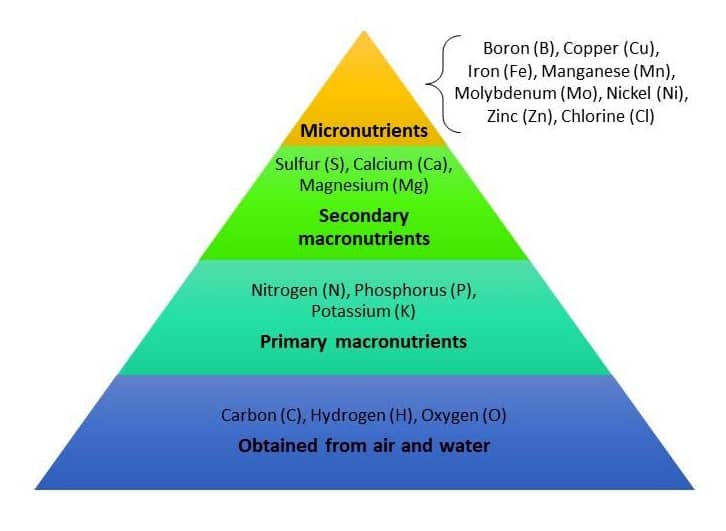
Generally, I prefer organic fertilizer to enhance the soil quality and increase the water absorption rate. But you can also use a balanced N.P.K in a ratio of 5-5-5.
Ensure that you provide your plant with both macronutrients and micronutrients.
Micronutrients act as a catalyst in the enzymatic reaction, along with helping in the transfer of genetic properties.
Likewise, macronutrients boost the growth and vitality of the plant.
However, be careful not to overfertilize the plant. Excessive fertilizer can slow plant growth and cause leaf browning and wilting.
Excess salt in the soil will kill beneficial soil bacteria and suffocate the roots with nutrients.
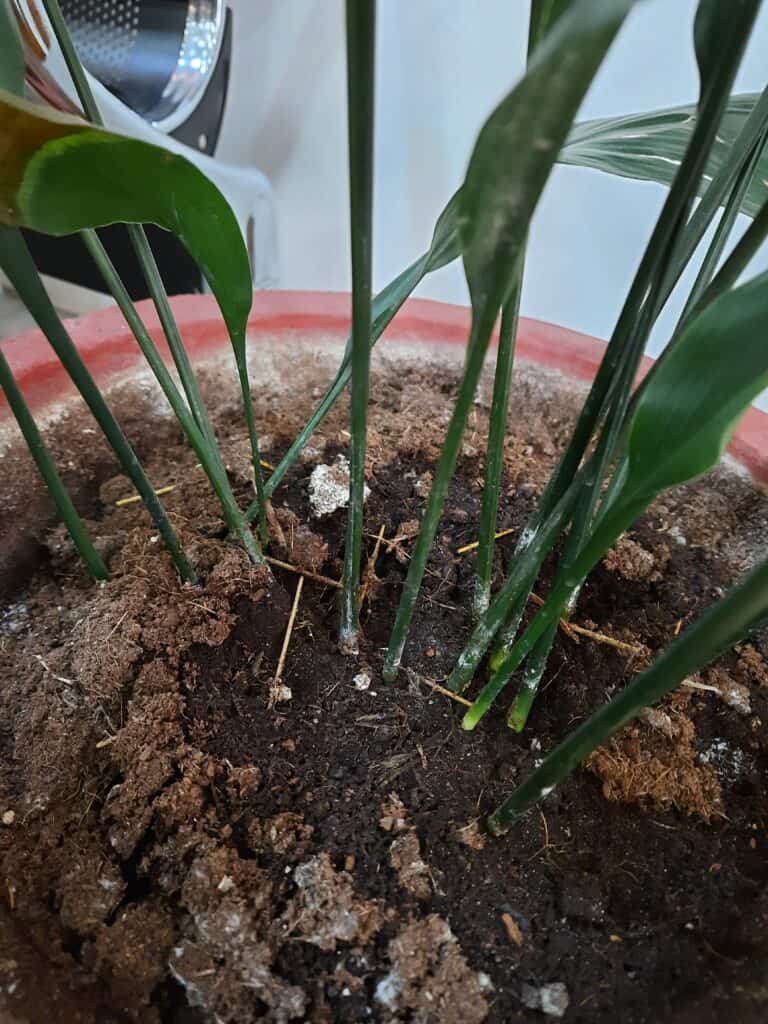
On the other hand, a nutrient-deficient Anthurium is often indicated by slowed young leaf growth and smaller leaves.
Tips to Fertilizer Anthurium Macrolobium Properly
- Always water the plant thoroughly before fertilizing them. Moisture present in the soil helps to trap nutrition within.
- Avoid fertilizer contact with the plant’s undershoot as it burns.
- If the plant is overfertilized, drench the plant in a pool of water to wash off excess salts.
- Watch out if you attach any particles of fertilizer to the leaves mistakenly.
- Fertilize your plant during the spring and summer months.
Some Recommended Fertilizers for Anthurium Macrolobium
| Fertilizer | NPK Ratio |
|---|---|
| EZ-gro Blossom Booster | 10-30-20 |
| Down To Earth All Natural Fertilizers | 0-11-0 |
| Better-Gro Orchid Better Bloom | 11-35-15 |
| Burpee Bone Meal Fertilizer | 6-8-0 |
| Peter's Professional Fertilizer | 10-30-20 |
7. Potting and Repotting Anthurium Macrolobium
Anthurium macrolobium is a medium-sized plant that requires a pot of similar size.
The perfect container size for Anthuriumm macrolobium is 5-8 inches.
A pot that is too small chokes the plant while also causing frequent rootbound.
While if the pot is larger, water does not dry quickly, leading to water stress in the plant.
Water stressed soil reduces airflow causing anaerobic activities. These unhealthy bacteria cause bacterial and fungal issues might lead to the root rot.
As mentioned earlier, the plant is a moderate grower. Thus, it does not require frequent repotting.
Consider repotting Anthurium macrolobium once every 2-3 years.

Consider repotting Anthurium macrolobium when the plant shows the following signs.
- Yellowing and browning of foliage
- Drooping, limping, and wilting leaves
- Stunted and dull growth
- Roots protrude out of the drainage holes
- Roots are severely entangled
Materials Required for Repotting Anthurium Macrolobium
| Material | Specification |
|---|---|
| Pot | Choose terracotta pots that hold up moisture. Use pots two inches bigger than previous one. |
| Fresh potting mix | Choose a potting mix that retains some moisture but allows good drainage. |
| Gardening Gloves | Use gardening gloves for safety. Gardening gloves are entirely optional. |
| Pruning shears | Get a sharp pruning shear or scissors to cut the healthy part of the plant. |
| Rubbing Alcohol | It will come in handy to sterilize the tools. |
Steps to Repot Anthurium Macrolobium
- First, you need to water your Anthurium a day earlier to repotting to strengthen the roots system.
- Take a garden trowel or fork and empty 1/3rd of the soil from the pot.
- Afterward, gently tap around the perimeter of the pot to separate the soil from the pot.
- Grab the stem base and take the plant out of the pot.
- Now detangle roots along with clearing the soil from the sources.

- Inspect for signs of root rot. Cut off roots if they’re mushy. However, remember to use sterilized pruning shears.
- Simultaneously, you can also prune the dead and damaged foliage and stems.
- Now, take a clean container and layer a few pebbles.
- Next, half fill the pot with the fresh potting mix and place the plant in the center of the pot. Here, the plant should be at the same depth as in the earlier pool.
- Now, fill up all of the remaining parts with the soil.
- Lastly, water the plant and leave it in a conducive environment.
Does your plant appear dull, droopy, and limp after repotting?
Relax, it is due to transplant shock and the plant will revive naturally once it gets fully adapted to the new environment.
To reduce the transplant shock, place the newly repotted plant in the same environment as it was earlier.
8. Occasional Pruning
Is your Anthurium macrolobium outgrowing its size? Are you facing problems with its unmanageable size?
Or is it not showing any active growth and is dull and leggy?
Well, if you are facing such problems, your Anthurium macrolobium needs a little shaping, i.e., pruning.

Pruning encourages new and healthy growth. Also, it forces the plant to produce side growth, which makes them bushier.
Generally, Anthurium macrolobium does not require frequent pruning. Consider pruning them if they show the above signs or if their parts are damaged and dead.
You can trim your Anthurium plant any time of the year but keep its growth and thickness. Don’t prune the plant too much to make it healthy.
Tips to Prune Anthurium Macrolobium
- Always use sterilized pruning shears to prevent the spread of diseases.
- Prune the Anthurium in the later months of fall (winter).
- Strictly avoid pruning when the plant grows actively, i.e., during spring and summer. It pushes back the growth of your Anthurium.
- Avoid cutting off more than 20% of the parts at a time.
- First, prune the dead and damaged parts, then only move to other sections.
- While pruning, it is best to cut off stems below the nodes as they can also be propagated.
- Cut off the dead, yellow, and diseased leaves and stems.
- Immediately throw the pruned parts into the garbage bin as parts can be toxic.
Propagation Methods for Anthurium Macrolobium
The good news is that Anthurium macrolobium is easy to multiply.
So, you can gift these varieties to your dear one or make yourself an Anthurium macrolobium edifice through propagation.
There are generally three different ways to propagate Anthurium macrolobium.
- Splitting the plants
- Stem cuttings
- Seed Germination
It will be difficult to harvest seeds of Anthurium macrolobium if there is a single plant of Anthurium as it first undergoes a female receptive stage followed by a male stage.
Hence, pollinating them might be a tricker for beginners. You need to collect female gamete and pollinate them when the inflorescence enters the male reproductive stage.
So I have proposed only two methods for propagation.
Materials Required for Propagation
| Item | Specification |
|---|---|
| Pruning Shear or Scissor | Get a sharp pruning shear or scissors to cut the healthy part of the plant. |
| Gardening gloves | These are entirely optional. |
| Container | Choose plastic pots that hold up moisture. For propagating, use small pots 2” deep like egg crates, seed tray. Alternatively, you can use a single pot 6-8” in size to propagate multiple cuttings. |
| Potting Mix | Choose a potting mix that retains some moisture but allows good drainage. Prepare homemade mix by adding an equal part of peat moss, humus, coarse sand, and perlite. Alternatively, use an African violet soil mix. |
| Rooting Powder | The rooting hormone helps to boost root growth. |
| Plastic bag | Use a black plastic bag to cover the newly propagated plant to retain humidity, moisture, and warmth. |
| Disinfectant or rubbing alcohol | It will come in handy to sterilize the tools. |
1. Propagation via Splitting
It is the easiest method of propagating Anthurium macrolobium. As the new plant possesses both the roots and shoots, it is a faster and more effective propagation method.
However, you will need an Anthurium with an excellent spread to propagate through this method. Follow these steps below.
Step 1: Prepare the Plant for Propagation
First, you need a robust plant for propagation. Water the plant thoroughly to strengthen the roots system. The process helps in easy adaptation.
Also, inspect the plant for diseases and pests. If the plant is infested, stop propagating.
Step 2: Uprooting the Plant
Take a gardening trowel and loosen the top layer of the soil. Then, remove 25% of the soil.
Afterward, gently tap around the perimeters of the pot to separate the soil from the pot. Then, grip the base of the stem and uproot the plant.
Step 3: Clearing the Roots and Pruning
Cleanse the soil attached to the roots and detangle the roots.
Step 4: Dividing the Plant
Inspect for a healthy offset. Then, separate the offset for the other plant. Cut the roots using a sterilized blade if you find it hard to separate the offset.
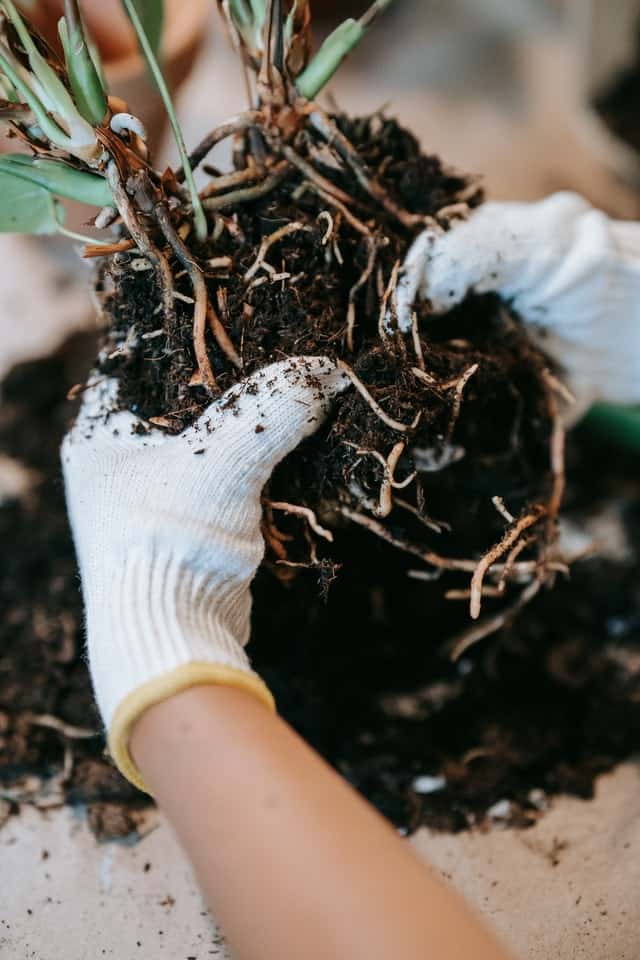
Step 5: Planting in a Growing Medium
Now, the plant is ready to be propagated. Take a clean pot; fill half of it with soil and insert the plant into the soil, filling the potting mixes in the remaining space.
Water the plant thoroughly and leave it in a brightly lit space for proper adaptation.
Learn more about How to Propagate Anthurium? here.
2. Propagation via Stem Cuttings
Though propagating Anthurium through stem cuttings is easy, it takes a longer time compared to splitting the plants.
Step 1: Inspecting for a Healthy Stem
For propagation, a healthy cutting is essential. One that contains pests or diseases cannot be successfully propagated.
Next, it increases the chances of infection spreading to even the plants.
Step 2: Taking the Cuttings
Look for the nodes after you inspect for a healthy stem bearing 2-3 leaves. Choose the one that is sprouting aerial roots as the process becomes more accessible.
However, you can also simply take any healthy stem-bearing nodes.
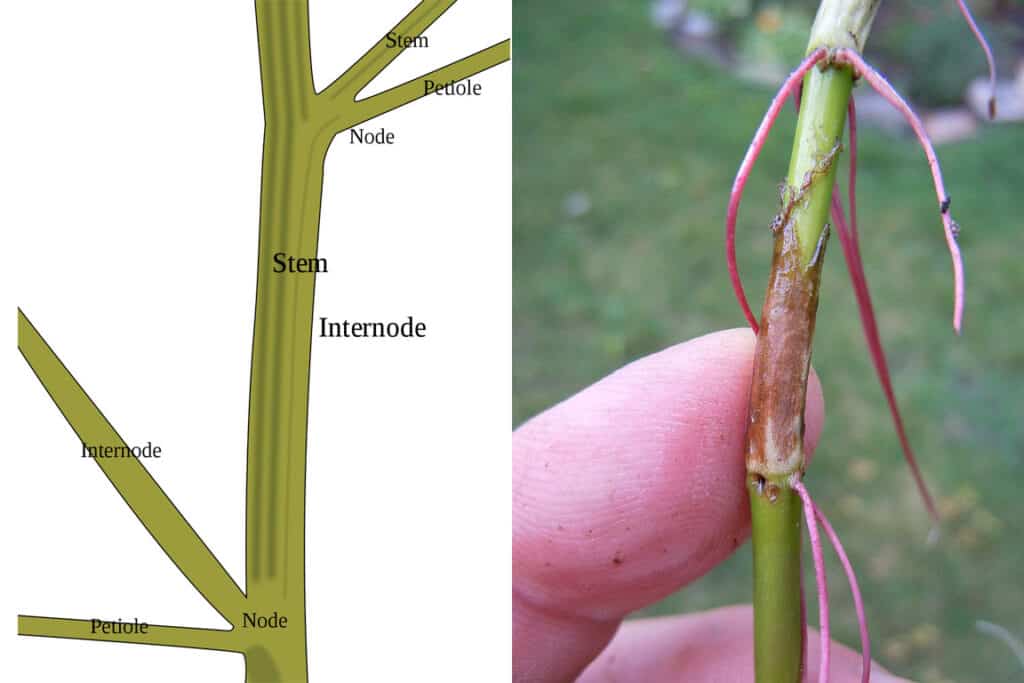
Now, make an incision at an angle of 45 degrees just below the nodes.
Here, ensure to use sterilized and sharp blades or knives for clear and infection-free cuttings.
Step 3: Preparing the Cuttings
It is beneficial to dust the cuttings with rooting hormones. It acts as a catalyst increasing the process of root formation and decreasing the chances of root rot.
Similarly, you can dust some cinnamon powder as it is antifungal.
Step 4: Planting the Cuttings
Now, the cuttings are ready for propagation. Follow the same process as planting the split plants for soil propagation.
Also, ensure that you insert the nodes under the soil as these are the parts that grow into roots.
For water propagation, take a clear jar filled with distilled water. Place the cuttings in the water and leave them in a bright space.
Finally, you will see the stems sprouting roots within 3-6 weeks.
If you need visual help for propagation, check out below.
Growth Rate of Anthurium Macrolobium
Anthurium macrolobium is mainly known for its vibrant, velvety leaves. Its leaves run on a long stalk and are broad heart-shaped circumscribed with wavy or curved edges that end in a pointy tip.
These edges divide the leaves into different lobes giving their specific name macrolobium.
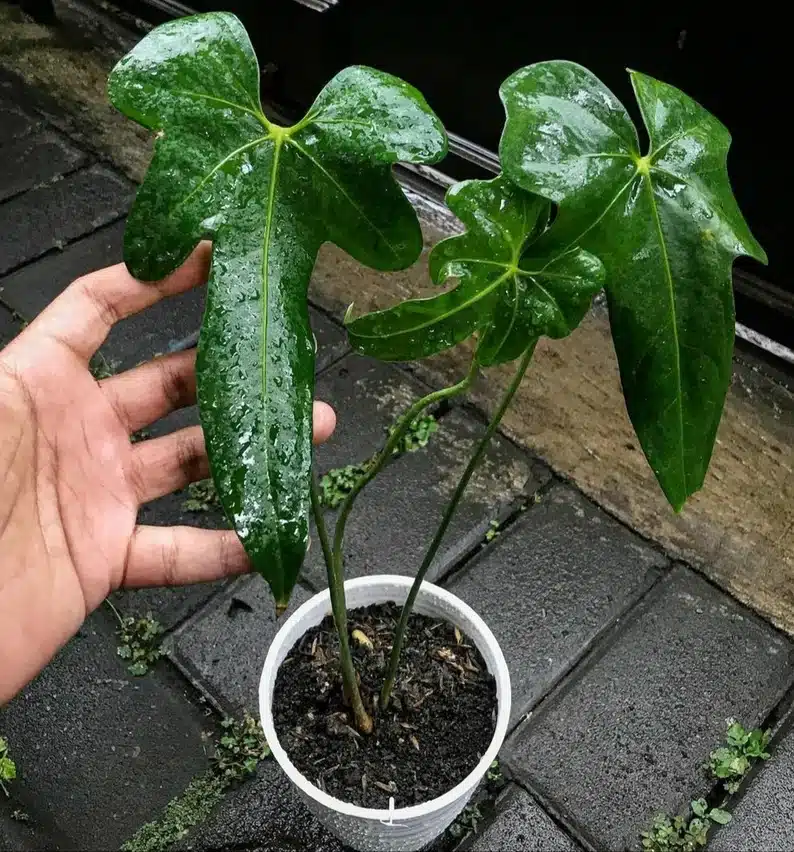
Anthurium macrolobium is slow to a moderate grower, grows up to 4 feet in height, and spread in 3 feet.
They can live up to five years or more when grown indoors as houseplants. If you want the plants to survive for longer, you need to consider propagation better.
Flowering Habits
The prominent features of all of the Anthurium varieties are either its flowers or vibrant leaves. And, Anthurium macrolobium is primarily known for its leaves rather than flowers.
Their blooms are not that showy and do not bloom too often. They are found to produce flowers in the natural environment.
However, the chances are less if you grow them indoors.
The blooms last for about three months and flowers, especially during spring and summer.
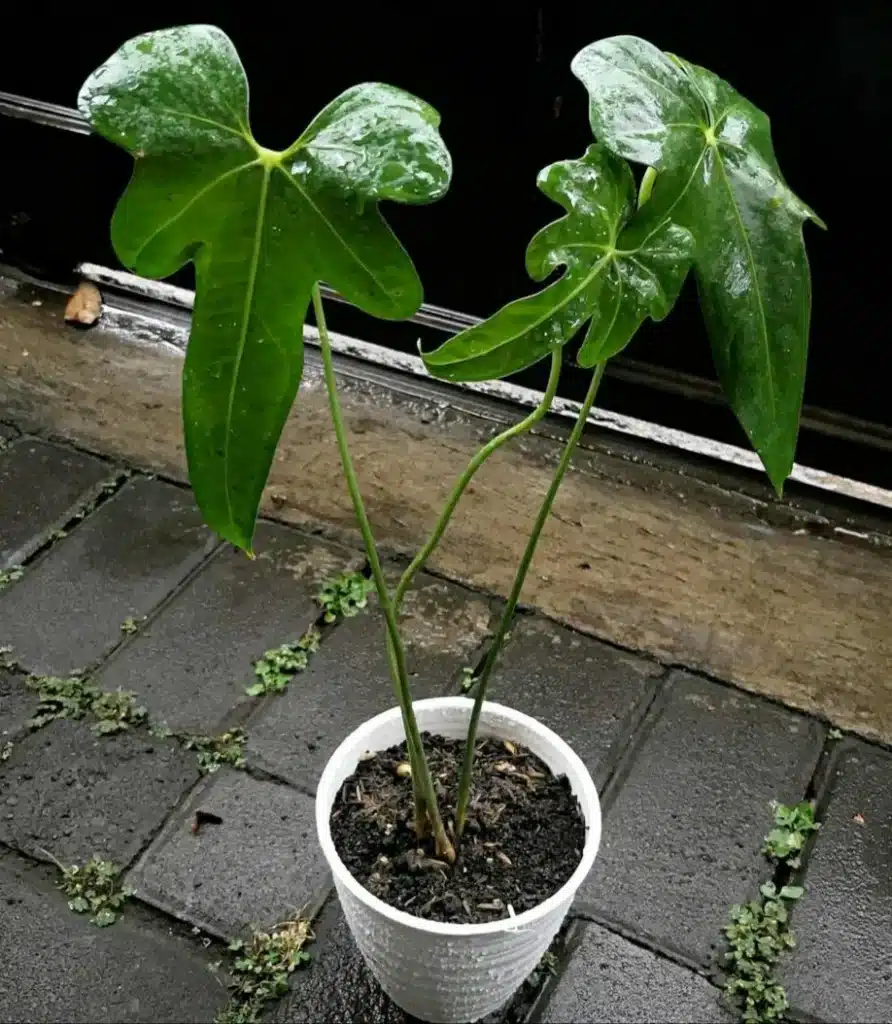
The flowers arise from the peduncle that produces inflorescence bearing spadix and spathe.
If the flowers are pollinated, they can develop fruits that ultimately give you seeds that you can use for propagation.
Toxicity of Anthurium Macrolobium
Do you have children and pets at your home? Better keep an eye on them if you home Anthurium macrolobium as all varieties of Anthuriums are toxic.
Anthurium macrolobium consists of calcium oxalate crystals which are the to humans and pets.
On contact with its sap, it causes eye and skin irritation. Similarly, ingestion causes nature, stomach and alimentary canal irritation, swollen lip, mouth, and vomiting in severe cases.
Likewise, your pets will grow irritable, drool, paw at the mouth, and vomit.
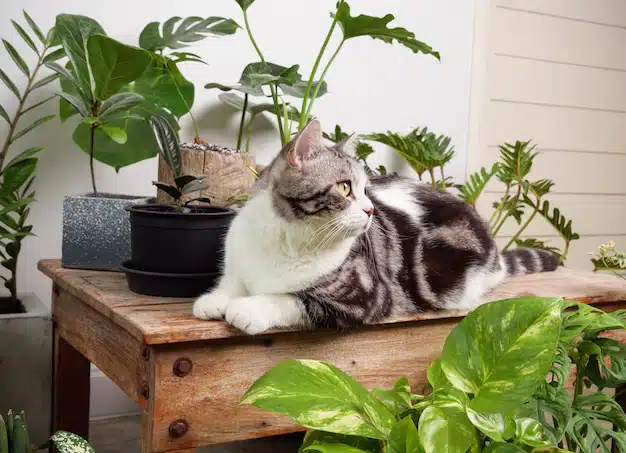
It is essential to seek medical assistance in case of human ingestion. Seek out health personnel as soon as possible.
In the case of pets, contact local veterans, or you can call on the following hotlines.
- APCC at (888) 426-4435
- American Association of Poison Control Center at (800) 222-1222
- ASPCA Poison Center at (800) 426-4435
Common Problems in Anthurium Macrolobium
As a tropical plant, Anthurium macrolobium is also expected to have pest attacks and bacterial diseases.
1. Common House Pests
Although the leaves of Anthurium macrolobium are vibrant and broad, they do not primarily attract pests.
However, if your plant grows under scarcity, it might easily catch problems.
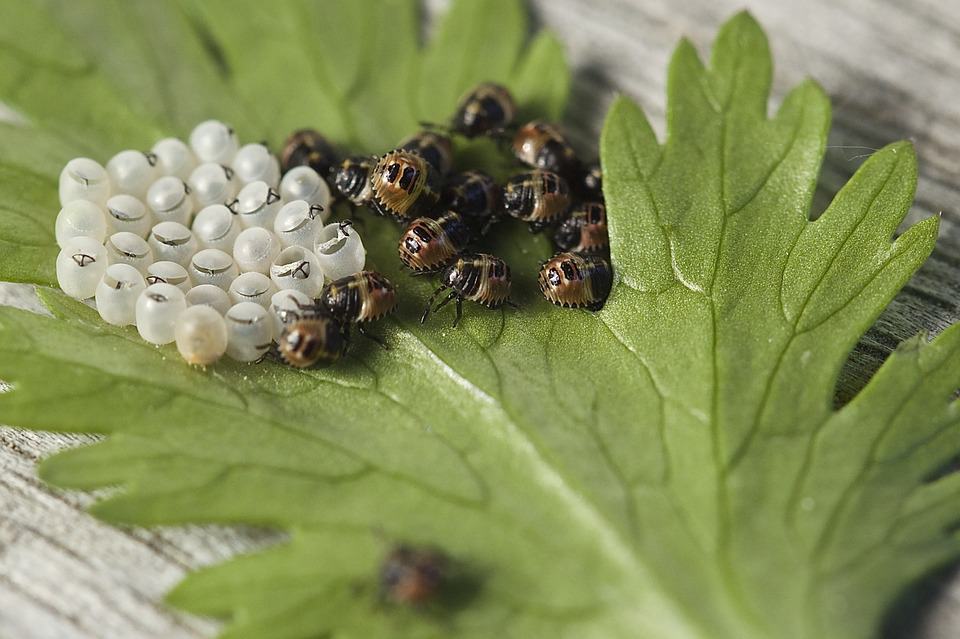
The culprit of Antrhurium’s pests problem is the high humid environment. Thus, maintain the ideal moisture without exaggerating the requirement level.
Some common pests in Anthurium macrolobium include Mealybugs, thrips, spider mites, and nematodes.
Here is a table containing descriptive information about these pests.
| Common Pests | Signs |
|---|---|
| Mealy Bugs | These tiny waxy bugs contain white-cotton like substance. They occur on the undersides of the leaves. |
| Spider Mites | These pests are yellow halo like structure on the leaves. When they attack, leaves appear speckled and wilts, limps, and droops. |
| Thrips | Yellow speckled and silvered pests on leaves. The leaves appear black due to thrips. |
| Nematode | The pest attack on the fresh roots to cause stunted growth. Thus, the leaves grow smaller and narrower. |
Treatment Measures
- The ideal way to treat nematodes is to solarize the potting mix, leaving the soil in scorching heat to kill them. Otherwise, you can also heat a small amount of the soil mix in the oven at about 140°F.
- A blast of waterworks for clearing visible pests like spider mites, mealybugs, and aphids.
- Take a cotton ball, dip it in 98% Isopropyl alcohol, and run it along the affected parts to kill the pests.
- Next, you can apply Neem oil or any other horticultural oil.
- Another way to treat pests is applying insecticidal soaps.
- However, in the case of severe infestation, I recommend using synthetic insecticides containing Pyrethrin.
Preventive Measures
- Inspect the plant before buying them.
- Avoid grouping Anthuriums with other infected plants.
- Wipe off the leaves with soap water once every week.
- Strictly avoid overhead watering.
- Also, don’t allow the plants to have excess humidity.
2. Horticultural Diseases
Generally, you can stay aloof from diseases if you provide your Anthurium with proper care.
But, when the maintenance is low, and the plant is weak, it becomes susceptible to diseases and pest infestation.
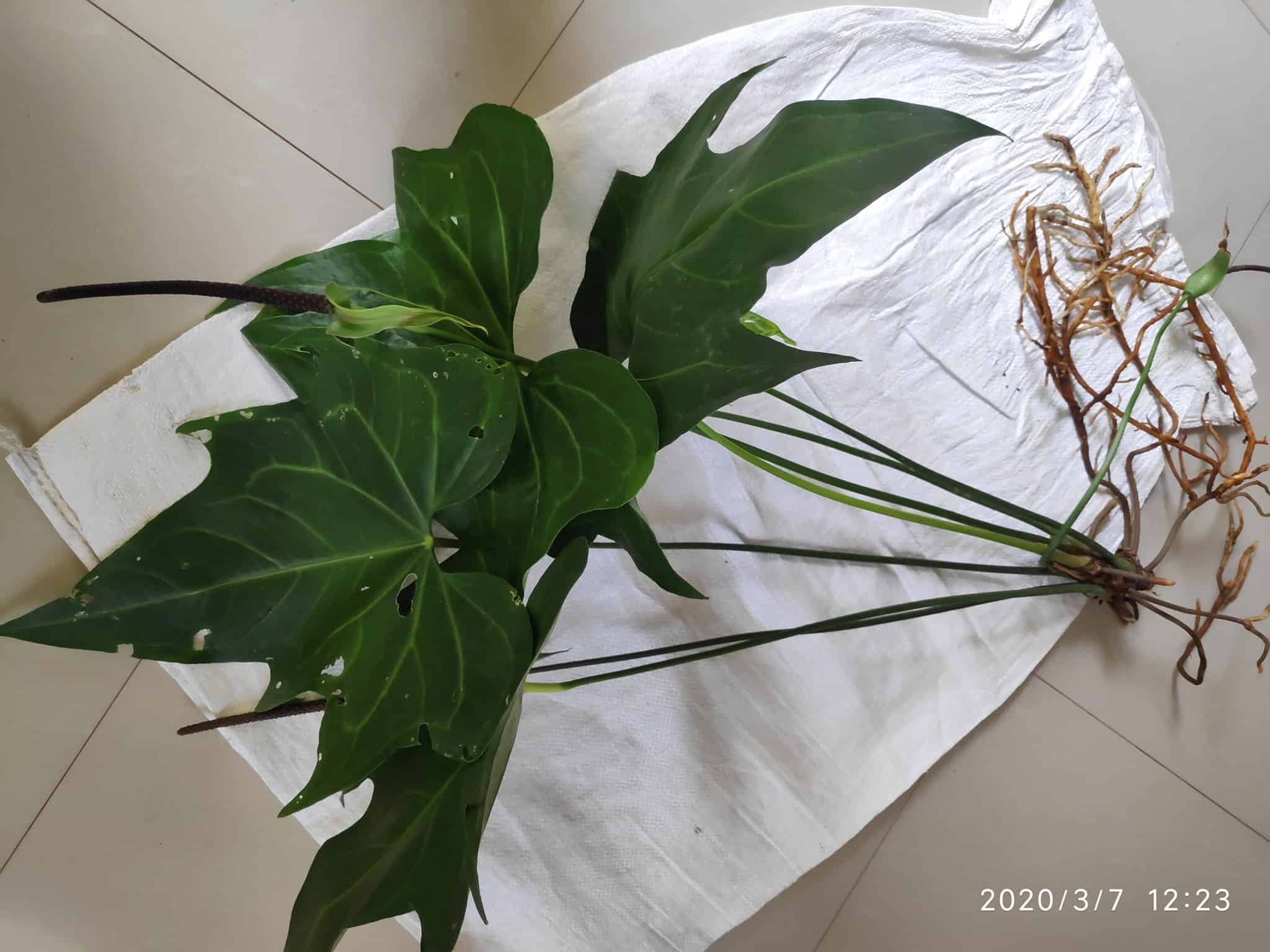
The commonly occurring diseases in Anthurium macrolobium are bacterial blight, root rot, and black nose disease.
Here is a table to describe Anthurium macrolobium in more detail.
| Common Diseases | Causative Agents | Symptoms |
|---|---|---|
| Rhizoctonia Root Rot | Rhizoctonia Solani | Drooped and wilting leaves and stems. Foul smell from the soil. Mushy, dark, and limping roots. |
| Phytophthora and Pythium Root Rot | Phytophthora nicotianae var. parasitica and Pythium splendens | Black to brown lesions on leaf surface. Wilting of leaf and stem, and, root sloughing. |
| Black Nose Disease | Colletotrichum Gloeosporioides | Dark lesions on the leaves followed by stem. |
| Bacterial Blight | Xanthomonas oryzae | Small water soaked marks on leaves. |
Treatment Measures
- Deadhead parts that are severely infected like root rot, dead leaves, and stems.
- Inspect for signs of root rot. If the root appears mushy and dry, prune it immediately. Afterward, apply fungicide, and repot in a fresh potting mix.
- Use fungicides containing copper, Benomyl, or Mancozeb effectively that help treat the aforementioned diseases.
- To treat bacterial blights, use Agromycin all over the plant and the potting mix.
Preventive Measures
- Water the plant according to its requirement avoiding soggy soil.
- Next, segregate unaffected plants from the infected plants.
- Reduce the excess moisture through bright diffused light during the afternoon and night.
Anthurium Macrolobium vs. Pedatoradiatum
As Anthurium macroloboium has been formulated from Anthurium pedatoradiatum, they share multiple similarities in plant body and care requirements.
| Factor | Similarities |
|---|---|
| Leaf color | Dark-green leaves |
| Growing Habit | Moist tropical regions |
| Light | Indirect bright light |
| Water requirement | Once a week |
| Temperature | 65 to 85° F |
| Soil | A mix of orchid bark, perlite and normal compost. |
| Fertilizer | A plant feed a balanced fertilizer once a month. |
| Propagation | Root-ball division an stem cuttings, |
| Potting | Every two years |
| Stem | Not branched |

However, they also generate some differences.
| Factor | Anthurium Macrolobium | Anthurium Pedatoradiatum |
|---|---|---|
| Plant height | 3-4 feet tall | 2-3 feet tall |
| Leaf shape | Heart shaped leaves with pointed end | Finger shaped leaves |
| Leaf size | 40 cm long | 20 to 30 cm long X 2 cm Wide |
| Blooming time | Spring and summer | Throughout the year |
Frequently Asked Questions About Anthurium Macrolobium
Is Anthurium Macrolobium Rare?
Anthurium macrolobium stands as a unique variety of Anthurium with a perfect blend of beauty, aesthetics, and craft.
This is rare because it is an artificially hybridized version of Anthurium. Its white venation amidst lush green broadleaf makes it one of the adorned variety.
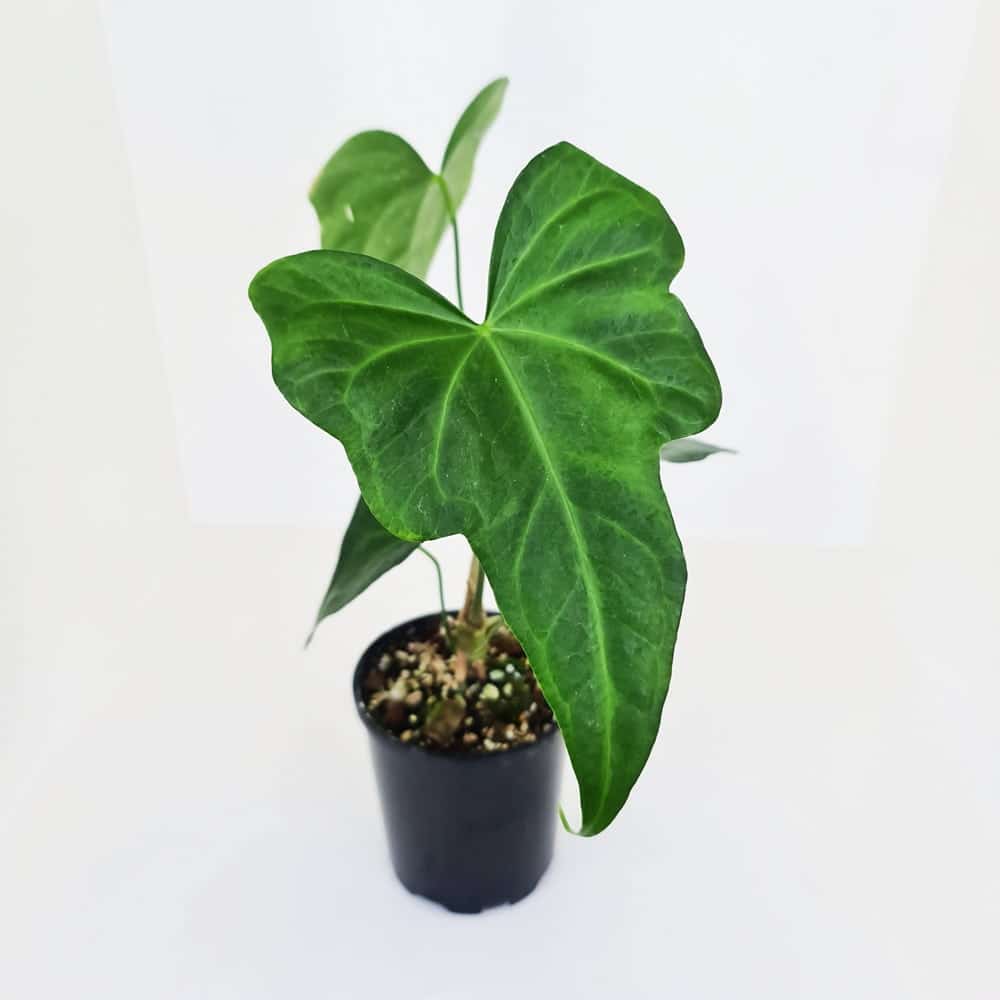
Does Anthurium Macrolobium Purify the Air?
According to NASA’s Clean Air Study Report, Anthurium is one of the plants that can help remove toxins from your corner.
It helps remove poisons like ammonia, toluene, xylene, and formaldehyde.
Conclusion
Like other Anthurium plants, Anthurium macrolobium shares multiple tropical botanical similarities including growth, toxicity, and care requirements.
It can increase the beauty of your space with its flattened leave and lively flowers if you keep it at home.
After reading this all, you may have got an idea of how you can treat your Anthurium macrolobium and grow best to leverage a matured plant.
Want to learn more about other stunning varieties of Anthurium and their care tips? Read about Anthurium Metallicum, Cutucuense, and Brownii.


